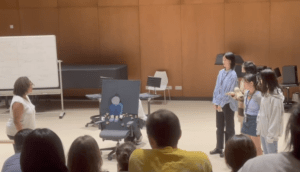Here is the video of our group presentation:
https://drive.google.com/file/d/1honqPF-iHE9nvqjpFNomaK6cXht1EtEW/view?usp=share_link
Title: Goggles
Successes:
We took our inspiration from the story of Omelas, in which people put all of their emotions onto one person. In our artifact, we want to depict what would happen if that changed and people were able to see other people’s emotions.Our project follows the basic requirements. In addition, I think our artifact engages both users and the objects. Also, the emotions shown are not singular, but complex and varied.
Failures:
However, it may raise some concerns about privacy, as not everyone would like to show their emotions to others. It would be more interesting, if we could have another object in opposition to the goggles.
Interaction:
I believe the artifact aligns with my understanding of the interaction. From my point of view, interaction is a kind of dynamic relation that strengthens the reaction between two actors (or things). And the reactions they make involve many senses, such as listening, speaking and thinking. In our artifact, the goggles enable a person to see others’ emotions, which strengthens the bond between them and further leads to the multi-sensory conversations. I think the performance would be enhanced if we could also show the potential problems caused by the artifact.
Working Process:
We did almost everything together. We held three meetings that everyone involved. During our first meeting, we shared our ideas and ultimately decided to choose goggles as our artifact. In our second meeting, we gathered to construct the goggles. I played a role in the entire process, from cutting cardboard to painting it. Before the presentation, we convened once more to clarify how to execute our artifact. We collectively finalized the script, and I provided some suggestions. Following our discussion, I took charge of the color ‘blue’ and wore a sweatshirt of the same color on the day of the presentation.”

Analysis for another group :
The artifact “mirror”, created by Group E, is also rooted in the story of Omelas. It adheres to the basic requirements, no electronic or advanced technology, no mind reading, set in the story backgrounds. Differing from our idea of empowering everyone with emotions and visualizing them into colors, they chose to keep the original setting. Through the mirror, citizens could see the miserable life of that poor child, especially during moments of their own happiness. This reminds people in Omelas not to forget the child’s sacrifice. I like their painting and the decoration of the mirror. They also added a cardboard-made horse to make their presentation more interesting. However, it seems that the invention of this artifact does not change the child’s poor situation and all the citizens still stayed in the Omelas. The interaction is a little bit simple, as it could only show the child’s situation rather than make direct changes. I could foresee the problem that when citizens in Omelas finally get accustomed to the scene, the artifact becomes meaningless; people would not empathy the child any more. I think it would be better if there could add some other devices that enable to influence the child, which can help the artifact go beyond visualization display and generate more senses.